|
STORY BY KAREN BOSSICK PHOTOS BY JOHN BOYDSTON Sun Valley photographer John Boydston was among dozens, if not hundreds, of Idahoans who ventured out into the chilly November air Tuesday night to capture photos of the aurora borealis. The colorful phenomenon blanketed the state from Sandpoint and Bonners Ferry in northern Idaho to Boise and Mountain Home in the south. Nationwide, it could be seen as far south as Florida.
|
|

Auroras usually appear green because the human eye is most sensitive to the green color spectrum. But some can appear pink, red, blue, purple and yellow.
|
|
|
“I only endeavored an hour as my fingers were frozen,” said Boydston. “The clouds were moving in, too, when I gave up.” The aurora was created by a series of geomagnetic storms, or eruptions of solar material and magnetic fields. They ‘re created by electrons from the sun colliding with oxygen and nitrogen atoms in the Earth’s upper atmosphere. Typically, they’re green. But this particular display was widely pink and red. The best time to see them is usually between 10 p.m. and 2 a.m.
|
|

Red auroras are less frequent than green ones, usually associated with intense solar activity.
|
|
|
That said, some people were able to spot them as early as 7:30 p.m. on Tuesday.
|